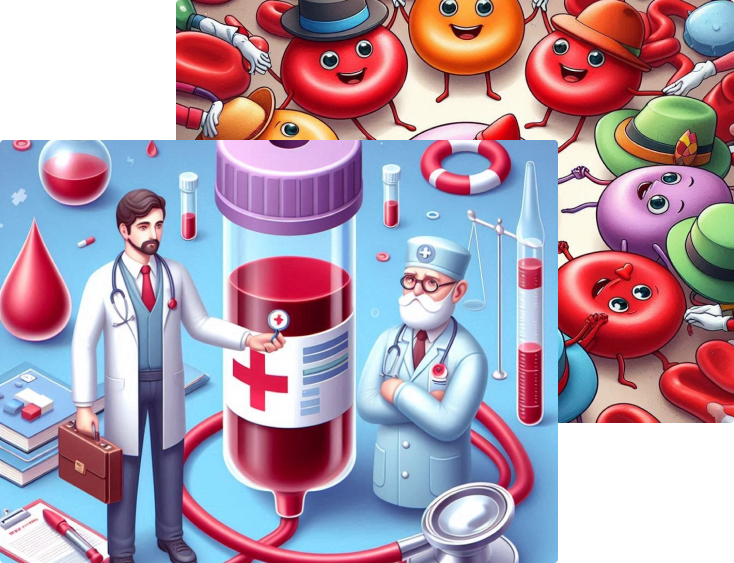About Thalassemia
Thalassemia
Thalassemia is a genetic blood disorder that significantly impacts the health and quality of life of those affected. In India, the situation is particularly alarming, with the country witnessing one of the highest incidences of thalassemia globally. Among the various forms of the disorder, thalassemia major stands out as the most severe. It necessitates regular blood transfusions for survival, often placing a heavy burden on patients and their families. Without these life-saving transfusions, the condition can lead to severe anemia, organ damage, and life-threatening complications.
Despite advancements in medical science, thalassemia patients in India face considerable challenges. Access to safe and timely blood transfusions is often limited, and there is a persistent shortage of compatible donors. The lack of public awareness around thalassemia exacerbates the issue, as many people remain uninformed about prevention, early screening, and the importance of regular blood donations. This knowledge gap not only limits early diagnosis but also contributes to the inadequate support systems for families dealing with the socio-economic and emotional toll of thalassemia treatment. Treatment costs are high, and many families lack access to sufficient medical or financial support, leaving them vulnerable and struggling to manage the disorder.
Type of Thalassemia
-
Thalassemia Minor (Trait): People with this condition are carriers and usually do not show symptoms, but they can pass the gene to their children.
Thalassemia Intermedia: This moderate form requires fewer transfusions than thalassemia major but still presents complications.
Thalassemia Major : The most severe form, thalassemia major, requires frequent blood transfusions, typically every 2-4 weeks, to manage severe anemia and other life-threatening complications.

The Thalassemia Crisis in India
With over 300,000 children affected by thalassemia in India, the country faces a dire situation. Every year, it is estimated that 10,000 to 15,000 babies are born in India with Thalassemia Major (TM), a severe and life-threatening form of thalassemia. These children require lifelong blood transfusions to survive, often needing transfusions every 2 to 4 weeks. This constant need for blood, coupled with India's ongoing blood shortage, creates an overwhelming challenge for thalassemia patients and their families.
Although the only potential cure for thalassemia major is bone marrow transplantation (BMT), also known as hematopoietic stem cell transplant (HSCT), this option is limited to a small number of patients. The reasons are multifold: the high cost of the procedure, a scarcity of BMT centers in India, and the difficulty in finding a suitable HLA-matched donor. Without a matched donor, the success rate of the transplant is significantly lower, further limiting access to this potentially life-saving treatment.
For the vast majority of thalassemia patients who cannot undergo a bone marrow transplant, regular blood transfusions are their only option for survival. However, the shortage of compatible blood remains a persistent and severe issue. Many thalassemia patients require phenotype-matched blood to avoid complications that can arise from repeated transfusions with incompatible blood. Without access to safe and compatible blood, these patients are at high risk of developing iron overload, infections, and immune reactions. Over time, these complications can severely impact their health, leading to organ damage and other life-threatening conditions.
Genetic Variants and Regional Prevalence of Thalassemia in India
India’s genetic diversity adds another layer of complexity to the thalassemia crisis. The country has a high prevalence of various forms of hemoglobinopathies, with β-thalassemia being widespread across the nation. The average frequency of thalassemia carriers in India is estimated to be around 3-4%, but certain communities show even higher carrier rates. For instance, higher prevalence is observed in Sindhis, Punjabis, Gujaratis, Bengalis, Mahars, Kolis, Saraswats, Lohanas, and Gaurs, where the carrier frequency is significantly above the national average.
In addition to β-thalassemia, other hemoglobin disorders are also prevalent in specific regions and communities. For example, Hemoglobin S (HbS) is highly common in the tribal populations of Southern, Central, and Western India, with carrier rates reaching as high as 48% in some communities. This variant is associated with sickle cell disease, a serious condition that also requires regular medical intervention, including blood transfusions.
In the Northeastern states of India, Hemoglobin E (HbE) is common, with carrier frequencies as high as 50% in certain areas. HbE is particularly prevalent in states like Assam, Tripura, and Manipur. Additionally, Hemoglobin D (HbD) is found in Punjab, with approximately 2% of the population carrying this variant.
DDL Blood Sewa's Revolutionary Initiatives: A New Hope for Thalassemia Patients
In response to these critical challenges, the DDL Foundation launched the DDL Blood Sewa project to revolutionize India's blood donation ecosystem and offer dedicated support to thalassemia patients. With over five years of extensive research into societal attitudes towards blood donation, DDL Blood Sewa aims to digitize, streamline, and optimize the blood donation process for both donors and recipients.
Key initiatives of DDL Blood Sewa include:
Genome Testing for Tailored Care: DDL Blood Sewa introduces groundbreaking genome testing services to identify compatible blood donors for each thalassemia patient. This advanced testing ensures that blood transfusions are as safe and effective as possible, minimizing complications and enhancing patient outcomes. Additionally, genome testing also opens up possibilities for bone marrow transplants, offering long-term solutions to the disorder.
Building a Reliable Donor Network: Each thalassemia patient is connected with a network of 40 to 50 dedicated and pre-screened blood donors who are phenotype-matched. This ensures consistent access to safe blood transfusions, which is critical for managing the ongoing needs of thalassemia patients.
Digitization and Transparency: Through an online platform, DDL Blood Sewa digitizes the blood donation process, improving efficiency in matching blood groups and connecting donors to patients. This technology-driven approach creates accountability and transparency in blood donation, minimizing wastage and combating the black market.
Public Awareness and Education: DDL Blood Sewa is committed to educating the public about the importance of blood donation and thalassemia awareness. The project works to sensitize potential donors, motivating them to contribute regularly and creating a culture of voluntary, unpaid blood donation.
Emergency Response Preparedness: DDL Blood Sewa enhances emergency response systems by optimizing processes for urgent blood donation needs. This ensures faster mobilization of donors in critical situations, reducing preventable deaths due to blood shortages.
Comprehensive Patient and Donor Support:With over 80 facilities developed to support donors and recipients, DDL Blood Sewa fosters a strong, compassionate relationship between patients and donors. This patient-centered approach prioritizes trust and long-term well-being, ensuring that thalassemia patients feel supported and cared for.
DDL Blood Sewa's pioneering initiatives, particularly its focus on genome testing and dedicated donor networks, are reshaping the future of thalassemia care in India. By addressing the blood donation deficit, raising awareness, and providing personalized care solutions, the initiative offers hope to thousands of children suffering from thalassemia. Through its comprehensive and innovative approach, DDL Blood Sewa is transforming the landscape of thalassemia treatment, offering improved outcomes and a brighter future for those affected by this serious genetic disorder.
